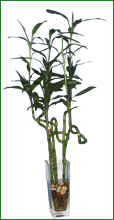The so-called Lucky Bamboo has become quite a popular houseplant in recent years. With a resurgent interest among the public in Eastern spirituality, lucky bamboo plants have found a welcome spot in many homes, where they are valued for their interesting, sculptural shapes as well as for their symbolism.
Brief History of Lucky Bamboo
With it’s fresh, green hues and it’s vigorous tenacity, bamboo has been considered a symbol of good fortune in Asian cultures for at least 4000 years. It has the ability to thrive in a variety of conditions and to adapt to its surroundings. The ancient Chinese practice of Feng Shui seeks to create a balanced arrangement of the elements of earth, water, wood, metal and fire in order to bring harmony to our living environments. Bamboo is valued as a perfect representative of wood, with its tall, vertical shape and verdant color. This element is said to have an influence on life energy, growth, vitality and physical activity. Because Lucky Bamboo is able to thrive in many areas of the home or workplace where other plants would not, it is frequently cultivated as a means to enhance the positive flow of energy or “chi” in these areas.
Ironically, the plant which is commonly sold as Lucky Bamboo is not really bamboo, but in fact a member of the Dracaena family (Dracaena sanderiana), plants which are well known for their durability under adverse indoor conditions. Because of its ease of care and it apparent resemblance to the true bamboos, this Dracaena is now widely grown.
Lucky Bamboo Care
Caring for lucky bamboo plants is very easy. Typically, they are grown in a few inches of clear water, perhaps supported by small pebbles, stones, or marbles. It is important that the water be kept clean and fresh and not allowed to stagnate. In areas where the local water is heavily treated with chlorine or fluoride, the leaf tips or edges of the lucky bamboo may become yellow or brown. This condition can also be caused by too much salt in the water, known as in “softened” water. Thus, it may be advisable to allow tap water to stand in an open container for 24 hours, allowing the chlorine and flouride to dissipate, before using it with your plants. In the presence of salts, it’s best to used filtered or distilled water.
Lighting
Appropriate light levels are also an important factor in caring for lucky bamboo. The plants grow naturally under the shady canopies of taller rainforest trees. Thus, they prefer an indoor location with bright, indirect light. They will perform well under artificial lighting. Too much direct sun can cause burning of the leaves. Too little light will lead to weak growth, stretching and poor coloration. Normal household temperatures are ideal.
Fertilizer
Since water contains no nutrients, per se, the best care for lucky bamboo plants includes the occasional use of a dilute solution of plant food. Without soil to buffer the fertilizer salts, the roots are susceptible to burning if the solution is too strong. Use any standard house plant food at about one-tenth the recommended dilution rate each time you change the water.
Getting Lucky Bamboo to Twist
Lucky bamboo is frequently seen growing in unusual twisted, curved, or spiraling forms, which seem to enhance its appeal and sense of mystery. The plant does not grow this way naturally. In fact, the curving shapes are produced by laying the plants on their sides, with light directed from the top and shielded from each side, causing them to grow in one direction only toward the light and opposite gravity. The plants are rotated regularly to encourage the spiraling form. Naturally, this is a time-consuming and labor-intensive process which justifies the somewhat higher prices commanded by lucky bamboos.
Your local florist can provide you with your very own lucky bamboo plant, and with just a little simple care, you too can bring a bit of harmony as well as elegant style to your living environment which will last for years. May good fortune smile upon you!



